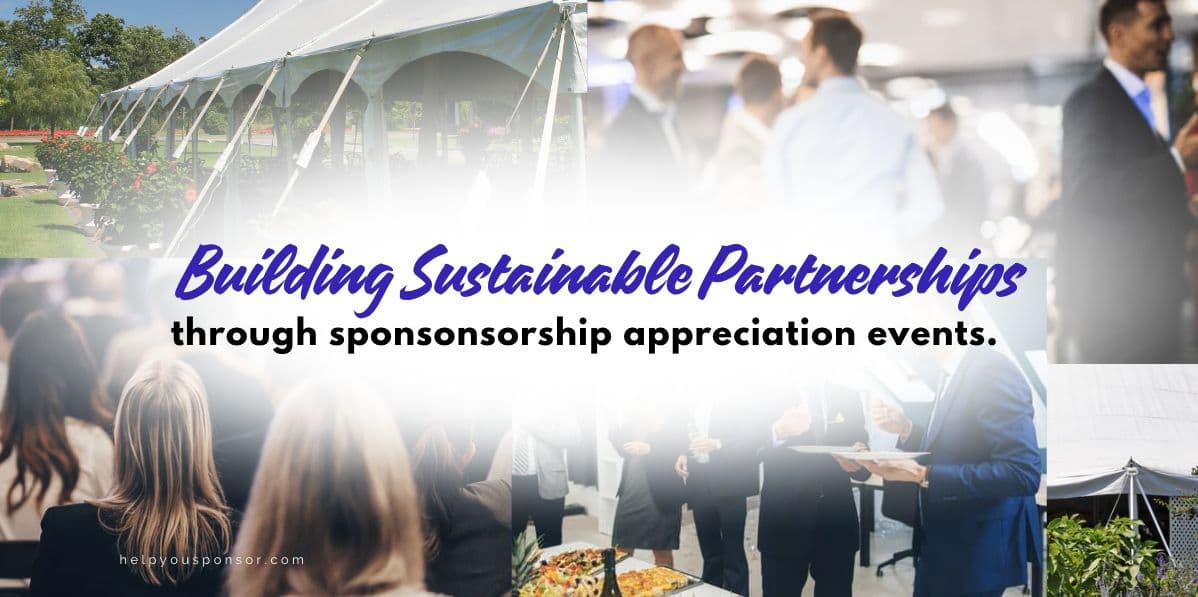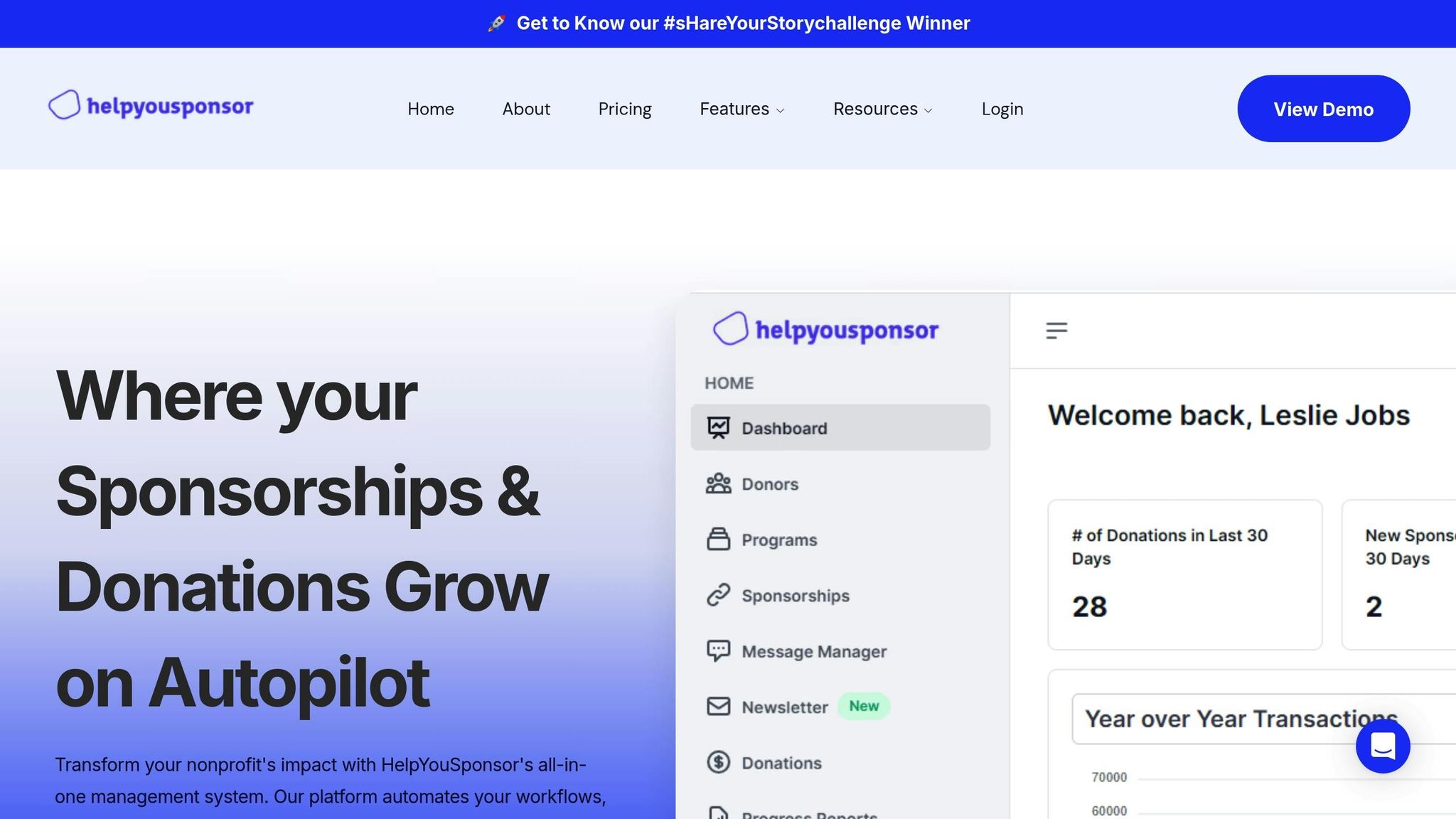Ultimate Guide to Sponsor Appreciation Events
Learn how to effectively plan sponsor appreciation events to strengthen relationships, boost loyalty, and showcase the impact of contributions.

Sponsor appreciation events are a way to say more than just "thank you" to your supporters. They help strengthen relationships, increase sponsor loyalty, and showcase the impact of their contributions. Here's a quick breakdown of what you need to know:
- Why They Matter: These events help nonprofits retain sponsors, boost funding, and expand their reach, while sponsors gain brand visibility, networking opportunities, and a chance to make a difference.
- Key Steps to Plan:
- Set clear goals (e.g., retention rates, attendance numbers).
- Create a budget covering venue, catering, and recognition materials.
- Align event activities with sponsor needs, like offering branding opportunities or interactive experiences.
- Recognition Tactics: Use tiered sponsorship levels, hands-on activities, and multi-platform recognition (digital, print, and in-person) to ensure sponsors feel valued.
- Post-Event Follow-Up: Share results, gather feedback, and maintain consistent communication to build long-term partnerships.
Event Planner Tips: How to Give Thanks After Your Event - Logan Clements
How to Plan Recognition Events
Organizing sponsor appreciation events requires a clear strategy, a well-defined budget, and alignment with sponsor expectations. Here’s a breakdown of the key steps to design events that not only recognize sponsors but also strengthen your partnerships. Start by establishing specific goals that will guide every decision you make.
Setting Event Goals
Define measurable objectives that benefit both your sponsors and your organization. These could include metrics like:
Donor Engagement Metrics:
- New sponsor acquisition goals
- Retention rates for existing sponsors
- Number of meaningful interactions with sponsors
- Total attendance figures
For instance, if your event focuses on advocacy, you could aim for targets such as securing 250 petition signatures or achieving an 85% attendance rate. Once your goals are in place, the next step is to determine a practical budget.
Creating an Event Budget
Craft a detailed budget that outlines all potential expenses. Key areas to consider include:
- Venue rental and catering
- Audio-visual equipment
- Recognition materials, such as plaques or awards
- Marketing and promotional efforts
- Staffing and volunteer support
Keep track of both direct costs and revenue sources to ensure your spending aligns with your event's objectives.
Matching Events to Sponsor Needs
To deliver value-driven experiences, it’s crucial to align your event with sponsor expectations. Research shows that 37% of event professionals find it challenging to meet sponsor demands. Here are ways to address this:
- Understand your sponsors' marketing goals
- Incorporate interactive opportunities to highlight sponsor brands
- Use clear metrics to track the event’s return on investment (ROI)
Engage sponsors early in the planning process. Collaborative efforts can lead to better outcomes, as demonstrated by a 36% increase in customer retention and a 38% improvement in sales win rates when sponsors are involved.
Creating Stand-out Recognition Events
Planning and executing sponsor events that leave a lasting impression requires thoughtful strategy. Research indicates that 80% of event organizers view in-person events as the most effective marketing channel. This underscores the need to create experiences that truly connect with attendees.
Recognition Levels and Benefits
To align with your event goals, design recognition levels that reflect the varying contributions of sponsors. A tiered structure not only ensures fairness but also helps balance sponsor expectations with your organization’s resources.
Here’s an example of a tiered recognition system tailored for nonprofit events:
| Tier Level | Contribution | Core Benefits | Exclusive Perks |
|---|---|---|---|
| Platinum | $25,000+ | Logo on all materials, VIP seating for 10 | Private reception, naming rights |
| Gold | $10,000+ | Premium placement, VIP seating for 6 | Program presentation opportunity |
| Silver | $5,000+ | Event recognition, reserved seating for 4 | Backstage access |
| Bronze | $2,500+ | Digital recognition, reserved seating for 2 | Meet-and-greet passes |
This structure ensures sponsors feel valued while offering perks that resonate with their level of support.
Hands-on Sponsor Activities
Engaging sponsors directly in your mission can create deeper connections. Here are two effective strategies:
- Program Demonstrations: Let sponsors experience your mission firsthand. For instance, Habitat for Humanity East Bay/Silicon Valley offered corporate sponsors the chance to participate in building activities. This not only showcased their mission but also provided a team-building opportunity for sponsors.
- Beneficiary Connections: Facilitate opportunities for sponsors to interact with the people or communities their contributions benefit. Project Sunshine, for example, offers both virtual and in-person engagements, allowing sponsors to see the impact of their support up close.
Multi-platform Recognition
To maximize sponsor visibility, adopt a multi-channel approach to recognition. Nonprofit email open rates average 20.39%, making digital platforms an essential tool for amplifying in-person acknowledgments.
Here’s how to incorporate multi-platform recognition effectively:
- Digital Presence: Highlight sponsors on your website, social media channels, and newsletters.
- Print Materials: Include sponsor logos in event programs, annual reports, and promotional materials.
- Visual Recognition: Display sponsor branding on event signage and presentation screens.
- Verbal Acknowledgment: Deliver personalized thank-you speeches that emphasize specific contributions.
With 74% of consumers more likely to engage with brands after experiencing their events, combining in-person and digital recognition ensures sponsors feel appreciated while enhancing their visibility. This integrated strategy strengthens relationships and helps sponsors see the value of their partnership.
Managing Event Operations
Pulling off a successful sponsor appreciation event requires detailed planning and flawless execution. Research shows that 41% of organizations face three or more critical risks during events, underscoring the need for careful preparation.
Venue Selection Guide
Choosing the right venue is a cornerstone of any successful event. Here are some key factors to consider when evaluating your options:
| Criteria | Key Considerations | Impact on Event Success |
|---|---|---|
| Location & Access | Close to airports, highways, public transit | Boosts attendance and ensures punctuality |
| Capacity & Layout | Room for activities, networking areas | Enhances event flow and attendee comfort |
| Technical Setup | Built-in AV systems, reliable Wi-Fi | Supports high-quality presentations and engagement |
| Budget Alignment | Rental fees, service costs, insurance | Keeps overall expenses in check |
Select venues that align with your event goals and provide essential amenities. Always visit the site in person to confirm its suitability.
Once the venue is booked, the next step is to map out a detailed timeline to ensure every aspect of the event runs like clockwork.
Event Planning Schedule
A well-structured timeline is key to smooth execution. Here's a general guide to help you stay on track:
12 Months Before:
- Assemble your event team, including key staff and board members.
- Define clear, measurable objectives for the event.
- Secure your venue.
- Draft a preliminary budget.
6 Months Before:
- Begin outreach to sponsors.
- Book vendors and entertainment.
- Develop a promotional strategy.
- Schedule regular team meetings to track progress.
1 Month Before:
- Confirm final catering numbers.
- Double-check all vendor arrangements.
- Conduct staff training sessions.
- Test all technical equipment to avoid last-minute surprises.
"Managing a great event starts with great planning. So, the first thing you should do is create an event planning timeline." - Mike Fletcher
Backup Plans and Risk Management
Even with the best-laid plans, unexpected issues can arise. A solid risk management strategy can make all the difference. Here are some common scenarios and how to handle them:
Weather-Related Issues:
- Secure indoor alternatives for outdoor activities.
- Set up communication protocols to share weather updates.
- Arrange temporary shelter options if needed.
Technical Challenges:
- Keep spare equipment on hand.
- Use redundant power systems to prevent outages.
- Maintain an emergency contact list for tech support.
Staff and Resource Management:
- Train your team on emergency procedures.
- Use real-time monitoring tools to track operations.
- Maintain open communication through designated channels.
To ensure a robust risk management approach, form a cross-functional team that includes representatives from logistics, security, communications, and finance. This team should routinely review and update contingency plans while keeping an eye on potential risks throughout the planning process.
"Preparation and proactive planning serve as the foundation for effective event risk management. Anticipating potential risks and instituting preventive measures is crucial to the success and safety of any event." - Aqsa Ayub, Content Writer, vFairs
After-Event Steps
The period after an event is just as important as the event itself. In fact, 53% of donors stop giving due to poor communication. This makes follow-up efforts absolutely critical.
One key step is to provide measurable outcomes that clearly showcase the event's impact. Transparency here can make all the difference.
Reporting Results to Sponsors
Post-event reports are your chance to show sponsors the value of their investment while building trust. Here's a reporting structure that works well:
| Report Component | Key Elements | Purpose |
|---|---|---|
| Event Overview | Attendance numbers, programming hours, countries represented | Offers a quick snapshot of the event's scale |
| Engagement Metrics | Social media reach, Q&A participation, media coverage | Highlights the broader reach and engagement |
| Visual Evidence | Professional photos, video highlights, testimonials | Evokes an emotional connection and brings the event to life |
| ROI Analysis | Sponsorship goals met, audience engagement data | Proves the value delivered to sponsors |
When presenting this information, avoid overwhelming sponsors with dense text. Instead, use visuals like charts, graphs, and photos to keep them engaged. Include metrics that matter most to them, like audience demographics or engagement rates.
Beyond the numbers, make it a point to gather sponsor feedback. This not only strengthens relationships but also helps improve future events.
Getting Sponsor Input
Sponsors’ feedback is invaluable for refining your approach and deepening partnerships. Here are a few effective ways to gather their insights:
- Post-event surveys: Quick and easy for sponsors to complete.
- Social media polls: A casual way to gauge opinions while boosting engagement.
- Embedded feedback links: Add these to thank-you emails for seamless input collection.
- Virtual focus groups: Ideal for more detailed discussions and brainstorming.
Take the Fine Arts Center’s collaboration with Bonefish Grill as an example. Sponsor feedback led to new benefits like VIP hospitality at receptions. Over time, this evolved into perks like priority reservations for subscribers and expanded promotional opportunities.
Keeping Sponsors Connected
Long-term retention requires consistent communication and meaningful engagement. A structured plan can help you stay on track. Here’s what it could include:
- Monthly impact updates: Keep sponsors informed about how their support is making a difference.
- Quarterly newsletters: Share event highlights and organizational achievements.
- Personal check-ins: Mark key milestones with a direct touchpoint.
- Early access to event details: Make sponsors feel like insiders by giving them a sneak peek.
For instance, Pride Financial Partners in Portland, Oregon, sponsored a local gala and added a creative twist: their logo was featured on bid cards, and they donated additional funds for every card submitted. This not only boosted donations but also made the sponsors feel like integral partners in the nonprofit’s success.
Using Software for Events
In today’s world of event management, software plays a key role in simplifying logistics while helping organizations connect with sponsors on a more personal level. These tools not only make planning easier but also enable smarter, data-driven ways to recognize and engage sponsors.
HelpYouSponsor Event Tools

Event management platforms are crucial for running successful sponsor appreciation events. HelpYouSponsor offers a suite of features designed to make event operations smoother and more efficient:
| Feature | Benefit | Impact |
|---|---|---|
| Donor Portal | Self-service donor access | Reduces administrative workload |
| Automated Communications | Scheduled updates and reminders | Keeps sponsors consistently engaged |
| Payment Processing | Stripe and PayPal integration | Simplifies donation collection |
| Multi-language Support | Available in 10+ languages | Broadens international accessibility |
One standout feature is the platform's integrated messaging system, which helps build stronger connections with sponsors. As Misi from Agua Viva shared:
"Great asset to our ministry! We're now able to combine our donor database, sponsorship database as well as several other office tasks into this one platform. It's going to considerably cut down on our administration time!"
Data-Driven Recognition
Beyond streamlining logistics, HelpYouSponsor empowers nonprofits to use data for more effective sponsor engagement. Organizations using the platform have seen sponsorships grow by an average of 3.8x thanks to better data utilization.
Personalized Recognition Tools
- Track sponsor preferences and engagement history.
- Create detailed, impact-focused reports.
- Tailor recognition efforts based on giving patterns.
Automated Engagement Features
The platform allows nonprofits to set up automated emails for various touchpoints, such as welcome messages, quarterly updates, impact reports, and event invitations, all tailored to a sponsor’s giving level.
Performance Tracking
With customizable dashboards, organizations can monitor key metrics:
- Donation trends
- Engagement rates
- Event attendance
- Program outcomes
The filtering tools make it easy to identify long-term sponsors who may need additional attention. For instance, managers can quickly locate donors who’ve been contributing for over five years but haven’t interacted with the donor portal recently.
Research highlights the value of personalized appreciation: sending thank-you notes can increase donor retention by 35%, and thank-you calls can boost retention rates from 22% to over 41%. HelpYouSponsor’s tools make it easier to implement and track these strategies.
Currently, nonprofits manage over $19M in donations through the platform. This demonstrates its ability to handle large-scale recognition efforts while maintaining a personal touch. By leveraging these tools, organizations can deliver sponsor appreciation events that are both seamless and meaningful.
Conclusion: Making Recognition a Priority
Sponsor recognition is more than just a polite "thank you" - it's a strategic move that can drive deeper engagement and long-term success. Recent research shows that 86% of sponsors value corporate social responsibility, and 84% believe it plays a critical role in influencing customer decisions.
Building Sustainable Partnerships
Creating meaningful, lasting partnerships requires a year-round approach and clear communication. Stefan Felsing, CEO of SPORTFIVE, perfectly captures this sentiment:
"Only someone who can prove a clear, sustainable specification, authentic commitment and examinable results, will be successful in the long term (from a commercial perspective) and improve their sustainable footprint."
This focus on authenticity and measurable outcomes forms the backbone of successful sponsorship strategies.
Key Success Factors
The best sponsor recognition programs share a few standout characteristics that make them effective:
| Recognition Element | Impact | Implementation |
|---|---|---|
| Personalization | Builds stronger loyalty | Tailor recognition to align with sponsor goals |
| Consistent Communication | Fosters trust and transparency | Maintain regular updates and check-ins |
| Impact Demonstration | Highlights sponsor value | Use data to showcase measurable results |
| Multi-channel Recognition | Boosts sponsor visibility | Leverage websites, social media, and events |
These elements not only enhance current partnerships but also open doors to new, long-term sponsorship opportunities.
Future-Focused Strategy
A forward-thinking approach, grounded in personalized recognition and data-driven insights, is essential for attracting and retaining sponsors. Corporate sponsorship provides nonprofits with consistent funding or in-kind support while helping diversify revenue streams. Organizations that prioritize sponsor recognition often see higher retention rates and more robust partnerships over time.
Digital Integration
Digital platforms are a game-changer for sponsor engagement. Successful programs combine online outreach with personal interactions, creating a well-rounded and impactful recognition strategy.
FAQs
How can I plan sponsor appreciation events that meet my sponsors' goals and expectations?
To design sponsor appreciation events that truly resonate with your sponsors, start by digging into their specific goals. Have open conversations to uncover what matters most to them - whether it’s boosting brand awareness, connecting with key players in their industry, or making a meaningful impact in the community. Use this knowledge to craft an event that showcases how it aligns with their priorities.
Consider offering tailored sponsorship packages that address their unique needs. These could include perks like exclusive branding opportunities, speaking engagements, or VIP access. During the event itself, take time to publicly acknowledge their contributions and show genuine gratitude. This not only makes them feel valued but also lays the groundwork for stronger partnerships down the road.
What are some creative ways to make sponsors feel appreciated during and after an event?
To ensure sponsors feel appreciated, aim to provide experiences that are both tailored and unforgettable. For instance, consider arranging an exclusive VIP lounge or organizing a private reception where sponsors can mingle with influential attendees. These kinds of perks make them feel like a key part of the event.
Another way to recognize their contributions is by featuring them prominently throughout the event. Use eye-catching digital displays to showcase their logos or highlight their involvement. Publicly thanking sponsors during a recognition ceremony or presenting them with awards adds a personal touch that resonates. These small yet meaningful efforts not only express gratitude but also help nurture lasting partnerships.
How can nonprofits use digital tools to plan and host successful sponsor appreciation events?
Digital tools have the power to reshape how nonprofits organize and execute sponsor appreciation events, making the process smoother and more engaging. Event management platforms, for example, can handle tasks like coordinating logistics, tracking sponsorship agreements, and managing guest lists. This not only saves time but also cuts down on administrative headaches.
On top of that, digital marketing tools make it easier to connect with sponsors and attendees through tailored messages and real-time updates. This personal touch strengthens relationships and helps create an event that leaves a lasting impression. By using technology effectively, nonprofits can streamline operations and create meaningful, well-organized events that truly resonate with their sponsors.

